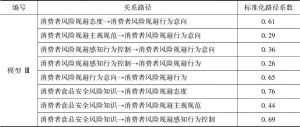论文
消费者的街头食品风险规避行为及其影响因素研究
摘要
消费者的街头食品风险规避行为可以有效减少食源性疾病的发生,促进食品经营者食品卫生状况的改善。本研究以计划行为理论为基础,融入知识变量,利用结构方程模型,分析消费者街头食品风险规避行为的影响机制。本研究采用分层随机抽样,对太原市的社区居民进行调查,共发放问卷540份,有效回收率为98%。结果显示,模型对街头食品风险规避行为的解释量最高可达76%。被调查者的街头食品风险规避行为水平普遍较低。知识、态度、主观规范和感知行为控制均可影响消费者的风险规避意向,且态度、知识对意向的影响最大。其中,消费者对个人卫生、用具卫生、资质认证等专业知识的了解程度最低。因此,为促进街头食品安全问题的解决,需加强相关法律法规的宣传,细化对消费者食品安全风险相关知识的科普教育,提高全民规避街头食品安全风险的积极性,最终提高全民的街头食品风险规避行为水平。
检索正文关键字
论文目录
- 一 引言
- 二 理论基础与研究假设
-
三 研究设计
- (一)研究对象
- (二)研究工具
- (三)调查方法
- (四)统计方法
-
四 研究结果
- (一)被调查者对街头食品安全有关知识的了解程度
- (二)被调查者对街头食品安全风险的规避行为
- (三)社会人口学特征中知识和规避行为的差异性
- (四)风险规避行为的影响机制
- 五 研究讨论
- 六 研究结论与建议
相关文献
查看更多>>>









